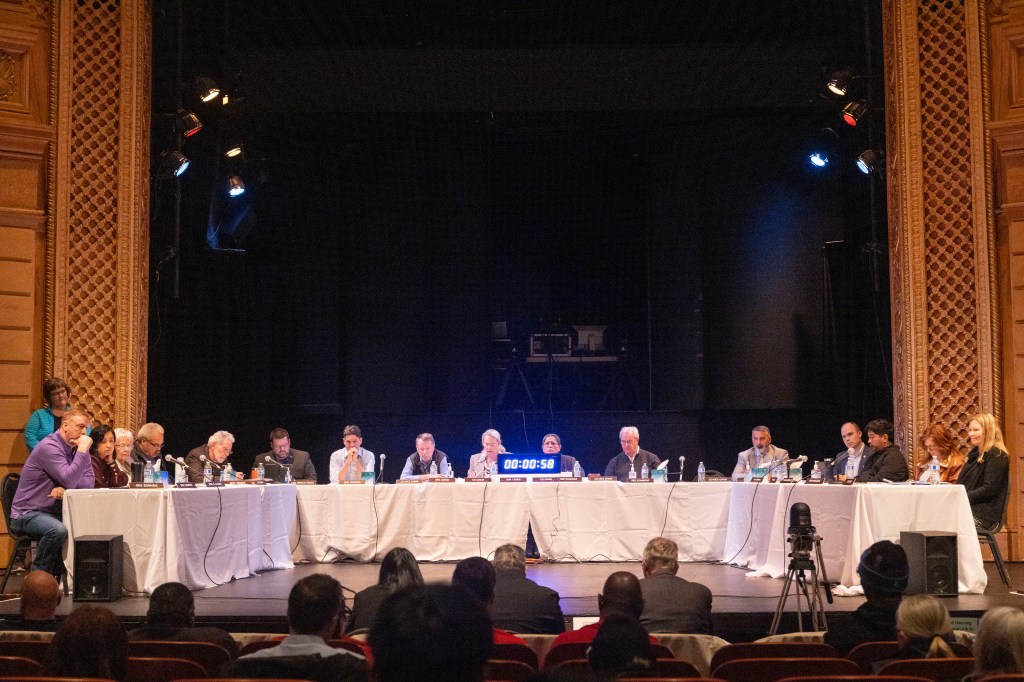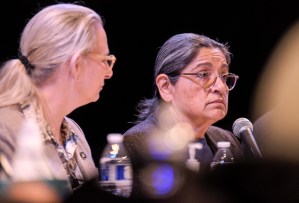Joint Committee on Ways and Means hears testimonies in Astoria
Published 12:18 pm Monday, March 31, 2025

- The Ways and Means Committee listens to testimony from the public at the Liberty Theater on Friday, March 28.
The Liberty Theatre filled with people seeking to testify — and to hear testimonies — in front of the Oregon Legislature’s Joint Committee on Ways and Means, which determines state budget policy, Friday evening.
As of that morning, 130 people had signed up online to testify about funding needs for programs on the local and state levels.
Though not everyone who signed up to testify got the chance to speak aloud, a clear community emphasis on funding for education and various infrastructure became apparent throughout the two-hour hearing.
Jarrod Hogue, the president of Clatsop Community College, asked that the committee invest $920 million for the Community College Support Fund, which is the primary source of state funding for Oregon’s 17 community colleges.
“Some folks here might be surprised to learn that the Community College Support Fund accounts for just about five and a half percent of the state’s total education spending,” he said. “Yet, investing in a community college delivers in one of the highest investments, producing skilled workers who become the backbone of our workforce and the taxpayers of tomorrow.
“Today, we’re facing rising operation costs. Labor, benefits, insurance, utilities, technology continue to climb … This investment is critical to keeping tuition affordable, filling workforce gaps and producing more taxpayers.”
Students and education advocates also asked that the committee support House Bill 3182 and 3183, the Student Basic Needs and Workforce Stabilizations Act. If passed, the bills would make an investment of about $22 million towards basic needs support programs, affordable student housing initiatives, and textbook affordability.
Funding requests also came from representatives for K-12 education programs, who also pivoted to disability resources for students. Governor Tina Kotek recently proposed a State School Fund allocation of almost $11.4 billion from the Legislature for the next two years, but some are concerned it’s not enough.
“Please know that the $11.4 billion budget proposal should be a starting point for the State School Fund, but education in Oregon deserves more funding,” said Craig Hoppes, the Astoria School District Superintendent. “Another priority is adequate funding for special education services. Currently, 17 percent of our students in the Astoria School District have been identified as special education.”
Since just 11 percent of students with disabilities are entitled to specialized funding from the state, he said that the district has had to seek out more special education and support staff to try and fill the gap.
The issue is a statewide one; Tyler Reed, the Neahkanie School District Superintendent, told The Astorian that 30 percent of the district’s incoming kindergartners had been identified as students with disabilities.
In addition to supporting the State School Fund allocation — though the Neahkahnie School District does not qualify for those funds — Reed sought to encourage the committee and legislators to do away with that 11 percent cap and fully fund students with disabilities.
Infrastructure requests ranged from the Columbia Memorial Hospital expansion to roads to wastewater treatment.
Last October, Columbia Memorial Hospital broke ground on a $300 million project to expand and replace the 50-year-old hospital. The new hospital has been designed to withstand and remain operational during a Cascadia subduction zone event, and could shelter up to 1900 people in the aftermath of such an event or other natural disaster.
While 97 percent of the project’s funding has been secured, CEO Erik Thorson requested a match of $6 million to leverage a $20 million grant from the Federal Emergency Management Agency to aid with the construction.
“This request represents just two percent of the total project budget, brings $14 million worth of federal funds into the state and completes the funding for this important project,” he said.
Thomas Jenkins is the chief steward of a local chapter of American Federation of State, County, and Municipal Employees, a union representing public and non-profit employees. He urged the committee to see the condition of Oregon’s roads as a workplace safety issue.
“Our very hardworking friends, sisters, brothers in labor at the Oregon Department of Transportation have warned us of challenges to the budget, particularly when it comes to emergency maintenance during winter months,” Jenkins said. “For those of us who must travel to work and work with travel, I urge you to continue funding transportation and to allow Oregonians to get to work safely and get home at the end of their shift.”
In addition to transportation, the discussion of sewage treatment was a recurring one; Bay City city manager David McCall for just over half a million dollars for a sewer lift station, while Warrenton mayor Henry Balensifer requested $18 million to help build a $35 million wastewater treatment plant that would support planned housing projects.
Another frequent topic was wildlife preservation in the face of federal funding uncertainty — Graham Klag, the executive director of the North Coast Watershed Association, encouraged the committee to continue supporting the Oregon Watershed Enhancement Board. Watershed councils get the majority of their funding from the board, and 30 percent of the board’s funding is federal.
“We are in need of the continued support of OWEB in the face of some of the funding challenges that would come down the road,” he said. “And ultimately, some of the challenges will come from not being able to implement some of our work without that funding.”
The North Coast Watershed Association does habitat work for salmon and other species, as well as invasive species management. Klag said the work is incredibly important for the county’s natural capital, and that the association has some crucial partnerships — Hampton Lumber, for instance, allows habitat work on their lands.
Others urged the committee to support the Oregon Department of Fish and Wildlife with a $1 million investment in Wildlife Services and a $20 million investment towards their Private Forest Accord grant program, which would support projects that benefit the fish and aquatic wildlife species and habitats covered by the anticipated Habitat Conservation Plan.
Kent Doughty, a former Oregon Department of Fish and Wildlife Employee who currently works with wildlife organization Seven Capes Bird Alliance, asked the committee to support and fund House Bill 3580 for a taskforce on eelgrass resources and House Bill 3587 for rocky habitat management.
Other testimonies throughout the hearing included a request for $1.5 million for Consejo Hispano’s new $3 million Casa Mariposa building downtown, capacity at the Oregon State Hospital, food insecurity, better wages for healthcare and social services workers and funding programs for domestic violence survivors.
Present at the hearing were Rep. Cyrus Javadi and Sen. Suzanne Weber, Tillamook Republicans whose districts encompass all of Clatsop and Tillamook counties.
“To my colleagues on the committee, thank you for making the trip to Astoria tonight,” Javadi said. “I know it’s a haul, but hearing directly from the people we serve is worth every mile. Nothing replaces a real conversation with real people who live with the outcomes of our decisions.”
Sen. Katie Lieber (D-Beaverton), one of the co-commissioners of the Joint Committee on Ways and Means, said the committee would be focusing on aiding crucial organizations and initiatives that will be hit hardest by cuts to federal funding.
“So much of our budget is tied to federal funding, and it is, slowly, going away right now,” she told The Astorian. “And I think those things are really, really going to affect the ability for the state, because you’re going to feel it — Oregonians on the coast are going to feel that federal funding going away, and our budget is not made to backfill the federal funding.”
The committee recently released a budget framework for the 2025-27 biennium that emphasized significant uncertainty surrounding federal funding and projected a budget of $987.5 million to support key investments.

Representative Tawna D. Sanchez, right, and Senator Kate Lieber, left, co-chairs of the Ways and Means Committee, open up the Ways and Means hearing in Astoria on Friday, March 28.
“To those of you who maybe paid attention to that framework we put out, we have just under a billion dollars,” said Rep. Tawna Sanchez (D-Portland), the committee’s other co-commissioner. “And if you were doing any math doing these last two hours, you might notice that the asks are a lot more … they’re more like two or three billion.”
The co-commissioners said the committee will do its best to provide for core mandatory state services in the face of potential federal cuts.
“We do our best to tell our own folks in the Legislature, there’s no bright and shiny new objects, there’s no fluffy stuff,” Sanchez said. “We’re just going to try and make sure that Oregonians have what they need as much as possible.”






